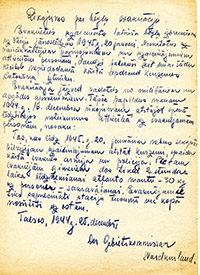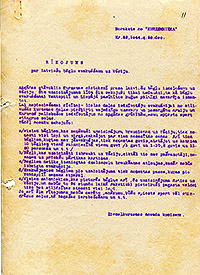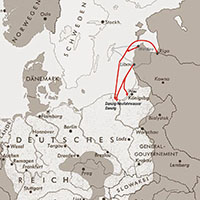The beginning of displacement
With the USSR Red Army approaching the eastern border of Latvia in the summer of 1944, an extensive refugee flow of Latvian population started westwards. People ran from the Bolshevik terror and likely repressions and additionally the refugee flow was due to the approaching frontline and warfare. Many Latvian people were coercively evacuated by the Nazi occupation authorities. The number of refugees in Germany was increased by the workers sent there during Nazi occupation, prisoners and concentration camp captives, as well as the Latvian soldiers transported to Germany.
At the beginning of 1945 there were 171 000 residents of Latvia in the German Reich.
| Northern Kurland district Commissioner’s order on evacuation of refugees. 25 December 1944. LVA, 2232. f. | |
| Order on evacuation of Latvian refugees to Germany. Transcript from the newspaper "Kurzemnieks" No 22. 28 December 1944. LVA, 2176. f., 2v. apr., 8. l., 11. lp. | |
| Civilian evacuation and flight by way of the Baltic Sea. From Riga evacuations began at the beginning of August in 1944 and continued until the 10th of October. More often than not, the end port was Danzig. Evacuation by ship from Ventspils(Windau) and Liepaja(Libau) began in September of 1944. The end ports in Germany were Danzig and Danzig Neufahrwasser. From Liepaja some ships also went to Pillau. Evacuations from Liepaja and Ventspils continued until the beginning of January in 1945. |
Those who arrived before the summer 1944 (workers etc.) 18 500
Civilian refugees in 1944 (August - December) 102 500
Soldiers 1944/1945 40 000
Prisoners in prisons and camps 1943-1945 10 000
Total 171 000
Arrival of Latvian civilian refugees in Germany
By sea from Riga (mainly to Danzig) 34 000
By sea from Liepâja (Gotenhafen) 40 000
By sea from Ventspils (Gotenhafen) 8500
From Riga and Kurzeme by land 20 000
Total 102 500
In the summer of 1945, at the end of the war, there were 107 000 refugees from Latvia in West Germany, i.e. the British, US and French occupation zones (at that time 25 400 people were in the war prisoner camps of the western Allies). 45.5% lived in the British Zone, 52% in the USA Zone and 2.5% in the French Zone. The proportion of men and women was 56%:44% respectively.
In addition 4600 Latvians found themselves in Sweden, 2100 in Denmark and 2200 in Austria in the summer of 1945.
The division of Latvians as to age and sex (as at 01.11.1947) according to the data of the so-called Hanau Files (data on Latvians in Germany, Austria, Sweden and Denmark)
| Year of birth | men | women | total | % |
| 1876 and earlier | 559 | 1368 | 1927 | 1,7 |
| 1877. – 1886. | 1819 | 2658 | 4477 | 4,1 |
| 1887. – 1896. | 3990 | 4764 | 8754 | 7,9 |
| 1897. – 1906. | 8692 | 8410 | 17102 | 15,5 |
| 1907. – 1916. | 14080 | 9579 | 23659 | 21,4 |
| 1917. – 1926. | 19236 | 9461 | 28697 | 26,0 |
| 1927. – 1928. | 1996 | 1377 | 3373 | 3,1 |
| 1929. – 1931. | 1511 | 1483 | 2994 | 2,7 |
| Children under 16 | 9829 | 9458 | 19287 | 17,6 |
| Total | 61712 | 48558 | 110270 | 100,0 |
Comparison of the number of Latvians in exile with the 1943 census data in Latvia across the age groups, expressed as percentage
| Age | In exile in 1947 % | In Latvia in 1943 % |
| 61 and older | 5,8 | 14,9 |
| 51 – 60 | 7,9 | 10,5 |
| 41 – 50 | 15,5 | 12,8 |
| 31 – 40 | 21,4 | 16,3 |
| 21 – 30 | 26,0 | 12,3 |
| 16 – 20 | 5,8 | 8,1 |
| 0 – 15 | 17,6 | 25,1 |




